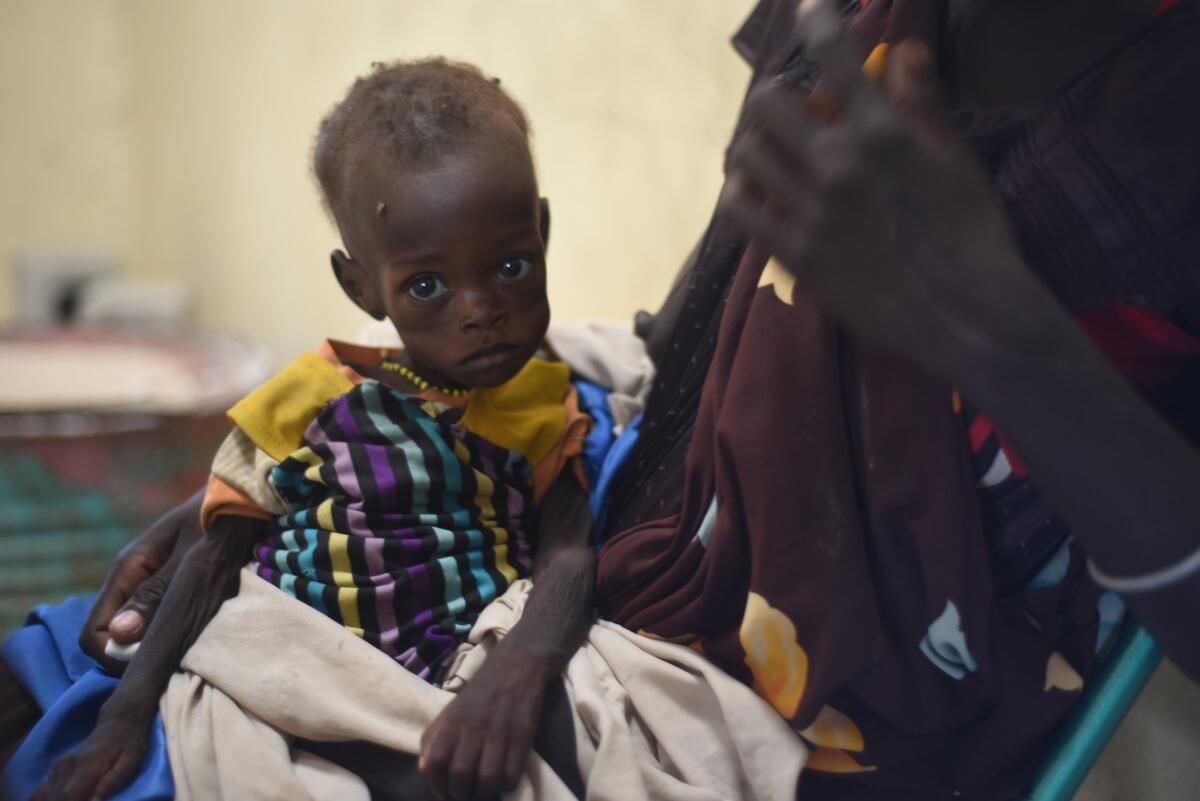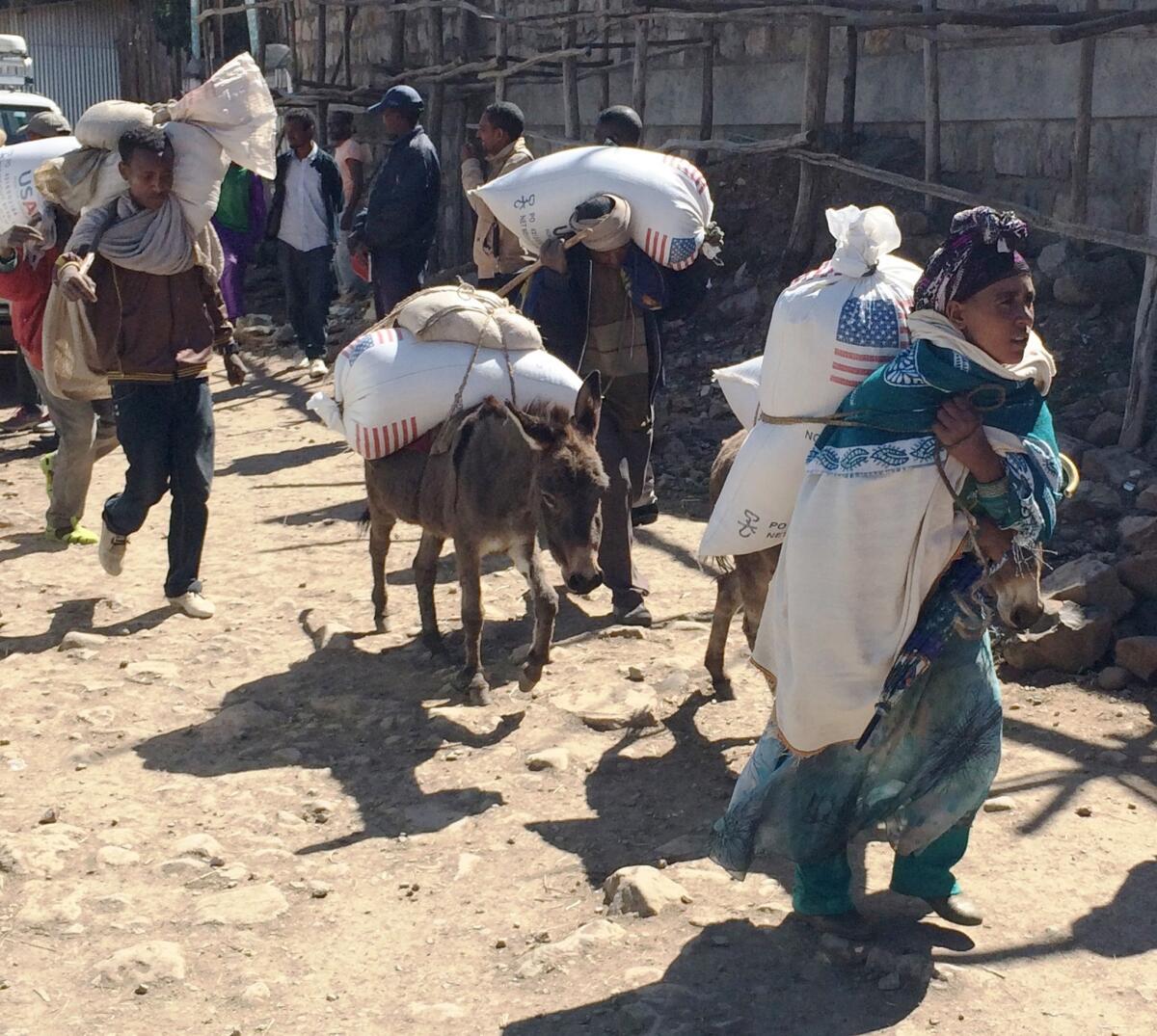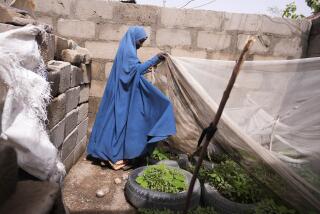People are starving in East Africa -- again -- as the world looks away

Nyagoah Taka Gatluak, a severely malnourished 1-year-old, sits on her mother’s lap at the Doctors Without Borders clinic in Leer, South Sudan, on Dec. 15, 2015.
- Share via
Reporting from JOHANNESBURG, South Africa — Humanitarian groups are growing increasingly concerned about two hunger emergencies unfolding in East Africa -- one caused by drought, the other by war.
Millions of people in Ethiopia and South Sudan are short on food, international agencies say, and in South Sudan, conflict has made it difficult for outside groups to help.
Ethiopia’s emergency unfolded swiftly, as the worst drought in around 60 years saw successive crop failures. Between August and October, the number of people in need of help doubled, and numbers have continued to rise sharply since, with the drought exacerbated by El Niño.
Now, 10.2 million Ethiopians are in critical need of food aid. International agencies are trying desperately to raise funds to prevent the food emergency from deteriorating into a full-fledged famine, but so far they say they have raised only a small portion of the cash they need to offer help.
An estimated $1.4 billion in humanitarian aid and donations is needed to address the crisis, according to a joint document issued by humanitarian agencies and the Ethiopian government.
In South Sudan, the crisis is taking place in slow motion, as the frozen wheels of a bitter two-year conflict leave people marooned, out of reach of humanitarian agencies. Some 40,000 of them are in a “Phase 5” hunger emergency, which, translated from humanitarian bureaucratese, normally means famine.
For technical reasons, however, it hasn’t formally been declared a famine, in part because humanitarian workers haven’t been able to get to some of the worst-hit areas to count how many people are dying.
NEWSLETTER: Get the day’s top headlines from Times Editor Davan Maharaj >>
“There are people who are -- right now -- facing catastrophic levels of hunger. They are starving,” said Challiss McDonough, spokeswoman for the World Food Program in a phone interview. “We have been very limited in our ability to get in and measure how bad things are.”
Many people in South Sudan couldn’t plant crops because of fighting. Around 3 million people are facing a hunger crisis and need assistance, according to humanitarian agencies. Of those, 400,000 are in a severe emergency situation and 40,000 are in a catastrophe.
“There are 12 million people in South Sudan. Out of 12 million people, 5 million people are food secure. It means that there are 7 million who have problems,” according to Serge Tissot of the U.N.’s Food and Agriculture Organization, which assessed the need last month.
“The situation is worse now in 2016 than it was at the beginning of 2015,” Tissot said in a phone interview.

Families begin their journey home with U.S. food aid from a distribution site in Denkena Kebele, Ethiopia, on Dec. 14, 2015.
Meanwhile, in Ethiopia, of the 10.2 million people in need, 2.1 million are considered acutely malnourished, according to McDonough.
She said the World Food Program has less than 5% of the funding it needs to help people in Ethiopia.
“Humanitarian needs globally are so enormous right now that donors are struggling to do anything near what’s needed. You’ve got layered global humanitarian crises,” she added, referring the conflicts in Syria and Yemen, and the massive numbers of refugees. “It’s hard for the donors to keep up.”
Cattle, which families rely on for meat, and oxen used to plow the fields to plant crops, have been dying in huge numbers in Ethiopia, though there is no official estimate on how many have perished.
“The issue is critical,” said Amadou Allahoury, the Ethiopia representative for the Food and Agriculture Organization. “The livestock sector is already highly affected.”
He said the U.N. hopes to save “the core breeding animals,” but so far lacks sufficient funding.
About 80% of the population relies on agriculture to survive, according to Allahoury. Ethiopia, Africa’s second-most populous nation with 90 million people, has made progress in reducing the vulnerability of its population in recent years, cutting its under-five mortality rate by two thirds between 1990 and 2012.
But the drought threatens to set back progress made in rural areas, where communities face a prolonged crisis.
A famine in Ethiopia in 1983-85 left an estimated 400,000 people dead.
The severity of the current drought is devastating communities and undermining the tremendous progress that the country has made in development over the last decade.
— John Graham of Save the Children, speaking of Ethiopia
John Graham of Save the Children said last month in a statement that people in the worst affected areas were forced to make terrible choices: slaughtering the oxen that would be used for planting next season -- should the rains come -- and eating the seeds saved for planting.
“The severity of the current drought is devastating communities and undermining the tremendous progress that the country has made in development over the last decade; we cannot stand by and watch that progress be lost,” Graham said.
Ethiopia was in drought even before El Niño hit. While El Niño typically brings more rain to California and the southern United States, it causes drought in other parts of the world, including eastern and southern Africa.
Despite an August peace deal designed to bring an end to South Sudan’s civil war, that country’s future remains just as uncertain. It began as a conflict between two rival arms of the government and army -- both of which split in two along ethnic lines as a struggle for power exploded at the end of 2013.
Fighting continues in some areas and progress on the key elements of the peace deal has been glacial.
Join the conversation on Facebook >>
Now, the situation has become increasingly complex as two dozen armed groups have sprung up, some threatening the main trade road that links the north and south, cutting off food supplies. As a result, said Tissot, food prices leapt tenfold in a year, leaving many families in areas not directly afflicted by the conflict unable to afford it.
McDonough said the World Food Program had to negotiate with myriad actors in order to get access to needy areas, and some were entirely cut off because armed groups wouldn’t provide the necessary security guarantees.
“There have been a couple of communities that have asked us not to bring food because they’re afraid they will be targeted by people with guns. The fear in these communities is very real,” she said.
Without peace, the humanitarian crisis in South Sudan will almost certainly deteriorate. The International Crisis Group warned last month that South Sudan would probably slide back into war in coming months. It called for international mediators to take firm steps to get the deal on track.
Follow @RobynDixon_LAT for news from Africa.
MORE WORLD NEWS
Furor over racist tweet lays bare South Africa’s persistent divide
Germany pledges to act after mass sexual attacks on women on New Year’s Eve
White House has doubts about North Korea’s nuclear test claims; U.N. Security Council vows action
More to Read
Sign up for Essential California
The most important California stories and recommendations in your inbox every morning.
You may occasionally receive promotional content from the Los Angeles Times.










